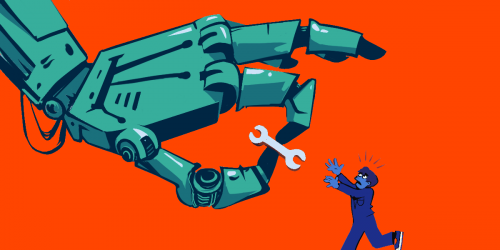If you are on Instagram, you have been probably bombarded by Instagram Stories and notifications about new features like emojis, chat themes, selfie stickers, and “cross-platform messaging” that will allow you to exchange direct messages with, and search for, friends who are on Facebook. But the insistent messages to “Update Messaging” minimize the extent of this change, which will blur the lines between the two apps in ways that might unpleasantly surprise users.
Images of notification promoting new features when updating the Messaging in Instagram
Even worse, if you choose to accept the update, you won’t be able to go back. Reading the fine print at the bottom raises questions about whether this is a mere update or an entirely new messaging system.
“When you update, the old version won’t be available.”
Images of notification promoting new features with fine print at the bottom "When you update, the old version won’t be available."
The “old version” Facebook refers to is simply the Instagram Direct messaging app. And the “new version” is a new messaging system that links Instagram and Facebook.
To put it simply, you now have “ Instagram Messenger.” After the “update,” you have in essence Facebook Messenger inside of Instagram.
Competition
Facebook announced their intention to merge Facebook Messenger, Instagram Direct, and WhatsApp in March 2019. The announcement promised new privacy and security features across the board, including end-to-end encryption, ephemeral messages, and reduced data retention. End-to-end encryption beyond WhatsApp hasn’t arrived yet, but cross-platform messaging between Messenger and Instagram is clearly one step in this grand plan. And its execution seems to be in step with Facebook’s custom of minimizing the extent—and invasiveness—of a business move in order to get users to click “ok.”
When Facebook acquired WhatsApp in 2014, antitrust enforcers already had concerns about what this meant for consumers. WhatsApp users had made the choice to use a service outside of Facebook, and many were concerned that this was not only an attempt to acquire the users’ data and crush competitors, but also to eventually merge WhatsApp into Facebook’s ecosystem. Facebook made promises to keep the two services operating separately, and Facebook broke those promises just two years later, with similarly unclear notice to users.
Facebook’s acquisition of Instagram in 2012 came the same story, concerns, and failure from enforcers to properly evaluate the acquisition. Now, this latest update represents another step towards merging Instagram into Facebook, and making it harder to distinguish one from the other. It’s not a coincidence that the “updated” version of the Instagram messaging app does not use the Instagram logo or a new one, but the Facebook Messenger logo.
In the initial 2019 announcement on merging the three messaging apps, Facebook called it a step toward “interoperability, saying, “We want to give people a choice so they can reach their friends across these networks from whichever app they prefer.” But communicating across services owned and operated by a single company isn't interoperability. If anything, Facebook isn’t trying to make its messengers interoperable; it’s trying to make them indistinguishable to regulators with competition and data-sharing concerns and to users. And, if this Instagram update is any indication, users are not getting the opportunity to make a clear, informed choice.
Choice
Tech companies like Facebook have mastered the art of distorting choice and consent. Here, you have the choice to change to the new messaging system— but you don’t have the choice to go back to the previous Instagram non-linked version. More importantly, hiding this detail in the fine print makes it an unclear choice to users who are surrounded by notifications, pings, and banners pressuring them into the change. Not forgetting that Facebook's policy means that this change will eventually link to your real name.
This is not an update, but a new messaging system from which you can’t switch back. There is nothing especially innovative about having colors in chats, or new emojis. Facebook could have added these to the Instagram Direct messaging app without bringing Facebook Messenger cross-platform functionality along with it. These are simply features presented to artificially devalue one of the systems, distract from the real changes, and manipulate users into changing to a different system. This is not an “update,” but a forced change to blur the lines between Facebook-owned apps.













